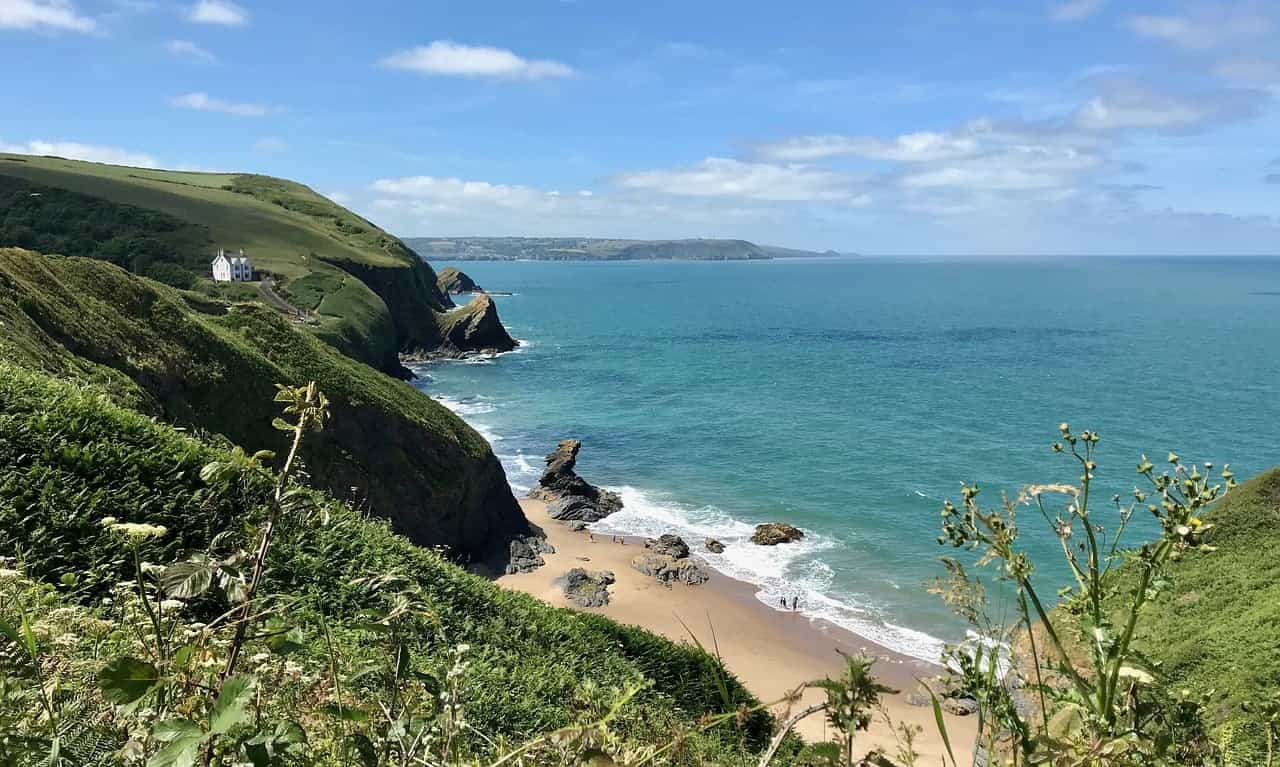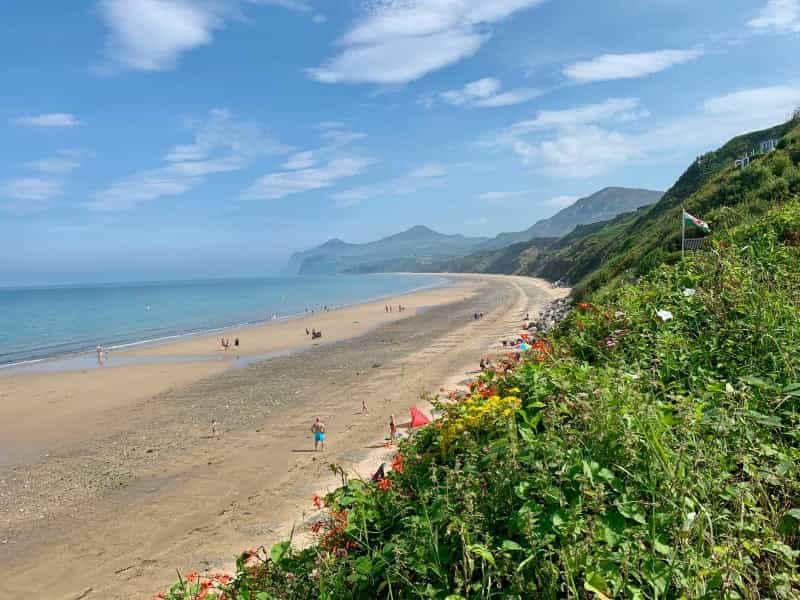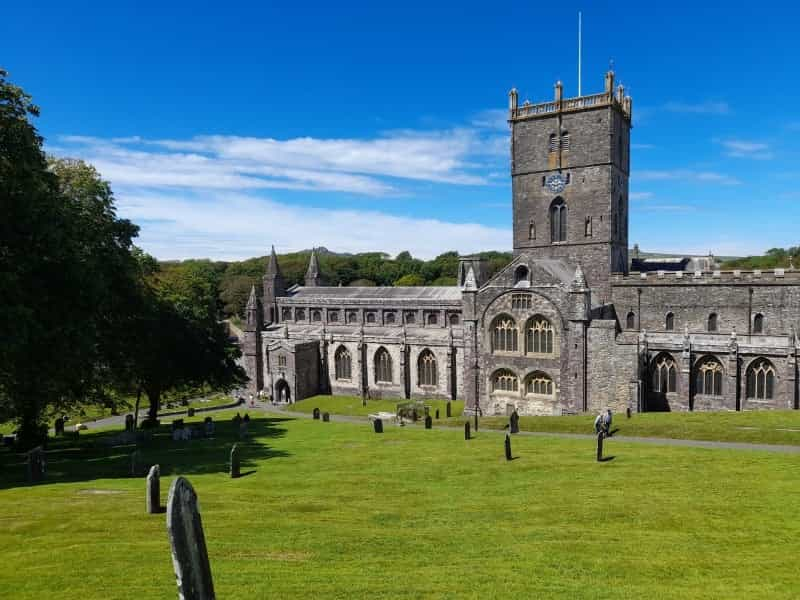The Wales Coastal Way camping road trip guide
The coast of west Wales is full of stunning beaches and historic attractions – and the best way to take it all in is a road trip along the Coastal Way, one of three national routes designed to showcase the best of the country’s spectacular scenery.
And one of the very best ways to take that road trip is to camp along the way – that way you can continue to take in the gorgeous views from dawn to dusk. Fancy waking up to the sound of the sea, watching the sun set over the waves, maybe even spotting a seal from your campsite? Then this is the trip for you.
This is a relatively compact route that’s very flexible – so whether you’re planning a long weekend, a family holiday or a motorhome road trip, read on for our guide to camping road trips along the Coastal Way.

What is the Coastal Way?
The Coastal Way is a 180-mile route that runs along the full length of Cardigan Bay in west Wales, taking in some of the country’s most stunning coastal scenery along the way. It’s a highly adaptable road trip route that can be covered in a long weekend or taken at a more leisurely pace to fill a week’s holiday.
Where does the Coastal Way start and finish?
The Coastal Way runs from St Davids in the south to Aberdaron in the north, and it’s equally rewarding to travel along its course in either direction.
What is there to see and do along the Coastal Way?
You could call the Coastal Way the Welsh equivalent of Scotland’s NC500 or England’s Atlantic Highway – with crashing waves on one side and the peaks of the Preseli Hills and Snowdonia National Park on the other there’s certainly plenty of gorgeous scenery to see along the way.
Along the route of the Wales Coastal Way are lots of fabulous beaches, castles, historic sights and wildlife-spotting tours. You can create your own itinerary to suit your own interests, but to help you along we’ve picked some of our favourite things to see and do while travelling on the Coastal Way.
10 top things to do on the Coastal Way
1. Abersoch beach: There are lots of lovely beaches on the Llŷn Peninsula, but Abersoch’s is a favourite because of its sheltered sands, its dog-friendly section and its watersports.
2. Portmeirion: If you only have time for one stop in the north, make it this one. The colourful seaside village of Portmeirion is like nowhere else in the country, with Italianate buildings and 70 acres of gorgeous gardens to explore.
3. Harlech Castle: The history of Wales has left it with more castles per square mile than any other country in the world – and Harlech has to be one of the best. This medieval fortress has stunning views over Snowdonia and the sea and is a fascinating place to explore.
4. Centre for Alternative Technology: Sustainability and the environment are at the forefront at this unusual attraction, which has lots of interactive exhibits and activities to get children interested in themes such as renewable energy and green building.
5. Borth beach: This is a great beach to visit at any time but it’s at its best around low tide, as this stretch of sand reveals an ancient petrified forest when the waves retreat.
6. Vale of Rheidol Railway: Step back in time with a ride on a steam railway as it makes its way along the 12-mile narrow-gauge track to the pretty waterfalls at Devil’s Bridge.
7. New Quay: Cardigan Bay has the largest population of dolphins in Europe, and New Quay is the best place to go if you’d like to see them. Boat trips run most days from April through to October, with expert spotters to tell you what to look out for.
8. Llanerchaeron: This elegant National Trust property was designed by John Nash, the man responsible for Buckingham Palace and Marble Arch in London. Visitors can explore the walled garden and farmyard as well as the 200-year old house itself.
9. Aberporth beach: The village of Aberporth is well worth a stop for its two sandy beaches, its rockpools and its sea fishing. There are also some great circular walks to the nearby beaches of Penbryn and Tresaith.
10. St Davids: Britain’s smallest city is packed with things to do, including the historic cathedral and Bishop’s Palace, outdoor centres with coasteering activities and boat trips, and lots of lovely places to eat and drink.
Where should I stay on the Coastal Way?
Camping is a great way to make the most of your trip on the Coastal Way – what better way to take in the wonderful scenery than to stay right there in the outdoors, looking out over the sea or watching the sun rise over the peaks of Snowdonia?
There are lots of ways to make that camping trip happen too: Pitchup’s listings include everything from simple farm sites that make great affordable breaks to smart glamping units where you can treat yourself to a mix of fresh air and luxury.
As the Coastal Way route sticks to main roads, it’s also a great choice for a motorhome road trip in west Wales. You’ll just need to make sure that your chosen site is suitable for campervans or motorhomes before booking.
Search campsites in West Wales
Five-night itinerary for the Coastal Way
The 180 miles of the Coastal Way are supremely adaptable to fit whatever length of time you’ve got for your holiday. It’s possible to split it into three sections to cover a long weekend (perhaps spending a night each around Machynlleth and New Quay) or use the journey as the focus of a week’s holiday, spending a couple of nights at each stop and exploring the coastline thoroughly.
The five-night itinerary we’ve outlined below fits nicely into a week’s holiday, allowing for travel time at the start and end of the week and travelling at a moderate pace that should allow plenty of time to visit attractions and stop to admire the scenery.

Day 1: Aberdaron and the Llŷn Peninsula
The Coastal Way officially starts in Aberdaron, at the very tip of the Llŷn Peninsula. This remote and fabulous area of Wales has some stunning coastline to visit, so we suggest booking a campsite near Pwllheli and using your first day to go surfing at Porth Neigwl or check out the unusual ‘Whistling Sands’ of Porthor on the north coast.
Pitches at Twnti Touring Caravan and Camping Park make a good choice for your first night – stay here and you’ll be able to stroll to the local pub before wandering back to a peaceful pitch that’s got countryside views to greet you in the morning. It’s also within a mile and a half of the well-known Tŷ Coch Inn, overlooking Porthdinllaen beach.
See all campsites near Pwllheli
Day 2: Pwllheli – Tal-y-Bont
Distance: 35 miles
Leave the Llŷn Peninsula behind and head into the Snowdonia National Park for a night in the little seaside village of Tal-y-Bont. The camping pitches and the cosy pods at Tyddyn Goronwy Camping Park are only a short stroll from the beach, so it’s worth getting there early enough to take a walk on the sand and then get a barbecue going while watching the sun set over the waves.
For a daytime stop along the route you might like to explore pretty Portmeirion or make stops to see the castles in Criccieth and/or Harlech – or you could take a detour inland to Blaenau Ffestiniog to explore Llechwedd mines or try out the adventure activities at Zip World.
See all campsites near Tal-y-Bont
Day 3: Tal-y-Bont – Aberystwyth
Distance: 52 miles
Fancy running straight from your pitch to a dip in the sea as soon as you arrive – or as soon as you wake up? Book a stay at Morfa Bychan Holiday Park, a few miles from Aberystwyth – this lovely clifftop site has direct access to the beach as well as gorgeous views out to sea. It’s also a good choice for those who suspect the sea of being too cold: once you’ve had a look at the beach you can take a swim in the heated pool instead.
The route from Tal-y-Bont to Aberystwyth passes by some particularly fine beaches, so take your pick from the sands of Barmouth, Borth and Aberdyfi, perhaps also leaving time for a visit to Machynlleth’s Centre for Alternative Technology.
See all campsites near Aberystwyth
Day 4: Aberystwyth
There’s so much to do in and around Aberystwyth, so we recommend spending a couple of nights here to make the most of it all. Perhaps you’d like to take a ride on the Vale of Rheidol Railway, explore lovely Llanerchaeron or head to Aberaeron for surfing or bodyboarding from the beach.
Aberystwyth is also packed with places to eat and drink, so this is the place to plan a restaurant outing if you’d like one.
Day 5: Aberystwyth – Cardigan
Distance: 54 miles
Have your binoculars ready, because today is the day that you’ll be going past New Quay, known as one of the best UK’s places to see dolphins and other marine mammals. Boat trips are the best way to boost your chance of a sighting, and it’s a good idea to book these in advance to get your choice of time.
Once back on dry land, stop off at one of the area’s beaches – Penbryn, Llangrannog and Aberporth all make good choices, as does Mwnt beach. A lovely way to see the latter is to stay at Nant-y-Croi Farm – set up in good time here and you’ll have time for a stroll to the gorgeous hidden cove before dinner. The pitches here look out over the bay, too, so you’ll still be able to enjoy the sea views while you eat breakfast.
See all campsites near Cardigan
Day 6: Cardigan – St Davids
Distance: 38 miles
The final stretch takes you into Pembrokeshire and on towards the final stop in the tiny city of St Davids. Thrillseekers might like to start their day in Cardigan, where sea kayaking, coasteering and other adventures are all on offer; for a quieter time, head to pretty Poppit Sands beach or take scenic walks around Strumble Head Lighthouse and Abereiddy’s Blue Lagoon.
Leave some time for a stroll around St Davids if you can: the cathedral and Bishop’s Palace are great places to visit, and the city has some lovely places to eat too.
The Coastal Way route comes to an end in St Davids, but if you don’t have to race straight home it’s worth planning a longer stay so you can surf at Whitesands Bay, take a boat trip to the birdwatching haven Ramsey Island and explore the pretty seaside village of Solva.
Your final night's dinner is likely to be a truly memorable one if you book a pitch at St Davids Farm Camping: stop by at the city’s shops and you’ll be ready for a barbecue with spectacular views. Every pitch here looks out over St Brides Bay, so you’ll be able to look out over the sea all evening and at first light too – the perfect finale?
See all campsites near St Davids

Campsites along the Coastal Way route
Where you stay along the way depends on your holiday style. Perhaps you’d like the simplicity of a farm site where you can stoke the flames of a crackling campfire as the stars come out overhead? Or maybe you’d prefer to cosy up in the comfort of a yurt or a cabin where beds are made up and woodburning stoves keep everything nice and warm?
Whichever way you choose, it’s certainly best to book ahead – that way you’ll get the pick of the best sites and make sure they have everything you need, whether that’s a swimming pool or a site that allows dogs. Pitchup has all sorts of sites available, from basic wild camping-style fields to fully equipped bell tents, so use the tick-box filters to narrow down the choices to ones that suit you.
Or perhaps you find yourself drawn to a particular location? Once you’ve planned your itinerary, simply check out what’s available around the spot you’ve chosen, whether that’s a seaside bolthole near Abersoch or somewhere that you can stroll to the pubs of Fishguard.
Coastal Way FAQs
Can I do the Coastal Way all year round?
Yes, the Coastal Way is accessible all year round, but you should be aware that some attractions will close in low season and you’ll have a more limited range of accommodation options if you travel outside of the main April-October season.
How long does it take to drive the Coastal Way?
The full route runs for 180 miles, with most of it on A roads, so it’s suitable for anything from a long weekend to a week-long road trip.
Can you drive the Coastal Way in a motorhome?
As the route mainly runs along major roads, it’s certainly suitable for motorhomes. Generally speaking, you won’t be able to spend the night in laybys or parking areas though, so it’s best to book a pitch in advance at a suitable campsite.
Can I extend my trip on the Coastal Way?
Of course – there are so many things to see and do in Wales. You could combine your road trip with some time spent on Anglesey, exploring the peaks of Snowdonia or visiting Pembrokeshire’s best beaches.